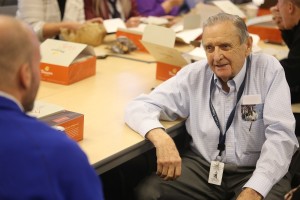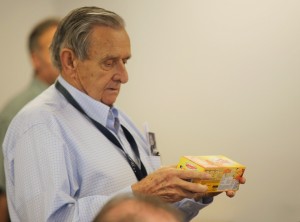
Submitted by Steven Friederich

Dick Kay never really liked using Excel to figure out his formulas.
The civil engineer in Emergency Management’s public assistance division said he preferred the old fashioned pen and paper method, scratching out algebra and arithmetic equations and then inputting it all in the computer databases.
Remarkably, his boss Alysha Kaplan says, he was never wrong.
“I’d go over the formulas again, just to make sure, and he was always spot on,” she said. “It’s amazing. … He manually tallied hundreds of entries over the years. He’s just sharp as a tack.”
“I trust my brain,” Kay said. “It’s the way I’ve always done it.”
At 84 years old, Kay says the time is finally right for him to retire. The Lacey man has lived in the same home with his wife Noreen for more than half a century.
For almost six decades, he’s been working, mainly for an assortment of public agencies, including stints at the beginning for the Federal Highway Administration and doing public works jobs in the Virgin Islands. He started with Emergency Management in 1996 as a disaster reservist. It’s a part-time position that depends on responding to disasters such as earthquakes and floods. Kay helped out a lot during the Nisqually earthquake in 2001.
Kay was responsible for going out and helping figure out just how bad the damage is after a major incident.
“I’m not bragging but I think I’ve been pretty pro-applicant,” Kay said. “I’m not doing anything wrong, but I’m going to fight until the bitter end to help them out if they’re eligible.”

The disaster reservist program assists individuals and households affected by a disaster. When the President declares a disaster, state Disaster Reservists are hired to deliver the programs and services. The state’s Human Services Program strives to maintain a pool of reservists who are immediately available when needed, just like Kay.
“We need individuals who learn quickly, work well in a team environment, have excellent communication skills, compassion and empathy, and the ability to work long hours,” the program description reads. “Reservists must be willing to travel statewide and have the ability to deal with confused, angry, or abusive clients. Basic computer skills are required for some positions. The work is hard, but Disaster Reservists know the rewards of helping the citizens of Washington during a disaster. Those best suited to do this work will be people who are retired, or choose not to work full time, or who have jobs that they can leave for months at a time.”
Kay became a full-time civil engineer a couple years after being part of the disaster reserves. In fact, he plans to return back to the disaster reservist program — but on a much less frequent basis.
After working almost non-stop for 61 years, Kay says, “I really enjoy my work and a big part of it was that my supervisors have always respected me and treated me respectfully. A supervisor has to treat people with respect. Treat your employees respectfully and like a human being.”
As part of the Federal Highways Administration, Kay helped design and work on building Interstate 5 through Seattle. At a recent retirement gathering, friends and colleagues noted that Kay has a reputation for telling stories while traveling on Interstate 5 – a practical blow-by-blow history of what it was like to build the state’s busiest freeway.
Kay says sometimes he’d get razzed about the traffic congestion problems in the Seattle area today and some of the design choices, such as building the interstate through the city.

“I just smile,” he says.
Friends and colleagues at Emergency Management say they’ll miss Kay, describing him as a “model of class” and a “great role model.”
“This career has been the most rewarding for me because I’ve been able to help individual people,” Kay told his colleagues.
“I just feel like he’s not only warm and funny and charming, but he also does his best to help,” said Erika Lund, who works in recovery management for the City of Seattle, but made sure to drive down to Camp Murray to be at Kay’s recent retirement party. “He’s not like my dad, but he’s very dad-like to me.”
The one story that stuck with friends and colleagues – and something Kay still swears by – is being able to catch fish by cutting up pieces of Velveeta cheese. As a retirement present, Kay was presented with a block of Velveeta – even though none of his friends were ever able to replicate Kay’s apparent success with his bait of choice.
“It works in Utah; it’s great bait, I swear,” Kay said with a smile.
Kay says he’ll be excited to spend more time with his wife at their home in Lacey.
“I love the community,” Kay said. “I just love my home.”
The couple have been married for 62 years now.
“I tell people we’ve had a lot of arguments at 62 years of marriage, but we tried to put it to bed before we go to bed,” Kay said. “That’s worked for us.”


















































